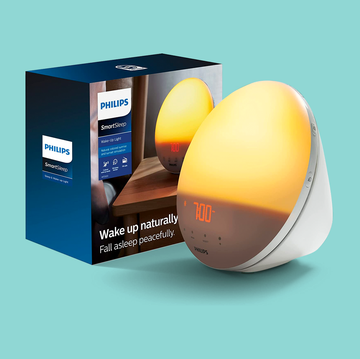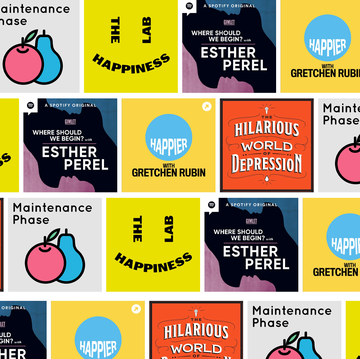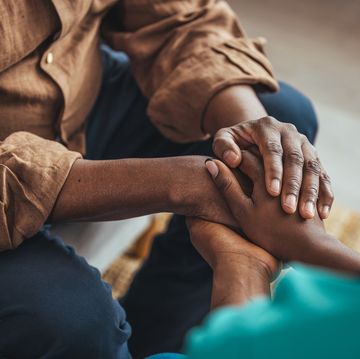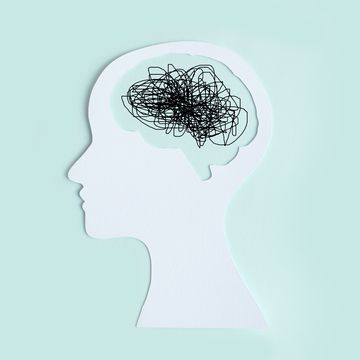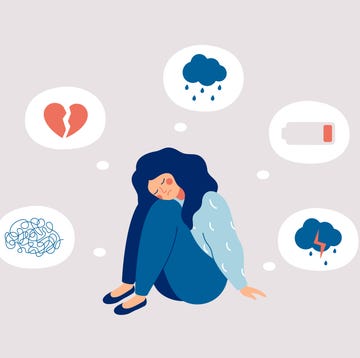Nearly one in 25 American adults has serious mental illness, which means odds are someone in your life is coping with anxiety, depression, OCD, bipolar disorder or another debilitating condition. Still, shame about mental illness — likely a holdover from when people wrongly believed such conditions were character flaws or a mother’s fault — can make it hard to seek help or even know what to say to those who struggle. To shine a light on the daily realities of mental illness, Good Housekeeping and the National Alliance on Mental Illness (NAMI) surveyed more than 4,000 people, and found that over a third had a close friend or relative with mental illness. In our special package on how to support loved ones with mental illness, women who live with these widely misunderstood psychological issues share what it feels like, and how you can make a difference.
For someone with borderline personality disorder (BPD), the simplest, most innocuous word or gesture from a friend or loved one can trigger intense emotional pain, which can lead to outbursts and troubling behavior.
“Once, early in our relationship, my boyfriend went to the kitchen and grabbed a glass of water, and he came back without bringing me one,” recalls Jacklyn, 32, of Oakland, CA. “That seems completely benign, but for me he was essentially saying, ‘You’re worthless; I don’t love you.’ I was instantly triggered by this.” Jacklyn says her now-fiancé is still surprised by her triggers and calls him “incredibly tolerant and patient.” Still, an episode can send her into a severe depression.
For others, the unpredictability can make it hard to maintain relationships. “I’m always on edge, waiting for my mood to dramatically change,” explains Jenna, 21, of Long Beach, CA. “I’m afraid everyone I know is going to leave me,” she says.
Jenna’s experience is typical for those with BPD. “People with borderline personality disorder don’t have a lot of self-confidence; they expect people to be critical of them,” says John Oldham, M.D., chief of staff at the Menninger Clinic in Houston, who adds that those with BPD are often convinced that they’re being judged negatively, even when that’s not the case.
There’s a lot we don’t know about BPD, but experts say there may be a genetic component, according to Dr. Oldham. There are environmental factors too: Some cases may be triggered by emotional abuse or abandonment during childhood. Even the name “borderline” can be confusing: “It’s on the border between a major mood disorder and a major impulse-control disorder,” Dr. Oldham explains.
While BPD was once thought to be untreatable, recent research has shown that with the right therapy, many of the 14 million Americans who will have it in their lifetime can manage their symptoms. Psychotherapy is considered most effective, Dr. Oldham says, but can present a challenge. “Patients have great difficulty trusting people because they’re so programmed to fear rejection; they ‘fire’ friends and sometimes ‘fire’ therapists,” he says. Jenna, who had been prescribed various medications and has been through many rounds of psychotherapy, found an eight-week course of Transcranial Magnetic Stimulation (TMS) to be helpful. (TMS is not FDA approved for BPD, but is for depression.) In TMS, magnetic pulses are delivered to the brain to stimulate nerve cells. “The effects were almost immediate,” Jenna says. “By the end of the first week, I noticed a significant difference in my mood, and I felt capable of experiencing emotions.” A 2017 study found that TMS, often used for depression and anxiety, profoundly improved the symptoms of BPD.
If a family member or loved one has been diagnosed with BPD, there are a few key ways you can be an ally to them:
- Try not to take the anger personally: It can be hard, but remember that the sometimes shocking behavior is a symptom, Dr. Oldham says. “If your daughter is yelling at you, saying, ‘It’s all your fault, you’re a lousy parent, and I never want to see you again,’ it’s the illness talking, not your daughter, whom you love,” he says. “It really helps when people say they’re going to be there for me,” says Jenna. “My parents tell me all the time, ‘We’re going to stand by you no matter what.’ ”
- Use neutral language: Because BPD involves heightened sensitivity, avoid statements that sound judgmental, such as “Calm down” and “Be quiet,” which can cause symptoms to spark even after the exchange is over. “It triggers this sense of ‘I’m not on your side; I think you’re repulsive,’ ” Jacklyn says. Instead, use phrases such as “I hear you” and “Did I get that right?”
- Remind them they are loved: “The first thing my fiancé said to me when he recognized that something was going on was ‘You are not your mental illness,’ ” says Jacklyn. “It meant so much to me.” Those struggling with BPD may have difficulty identifying and vocalizing their emotions, Dr. Oldham says, so periodically reassuring them that they are worthy of your attention can help them feel safe around you.
- Watch what you say on social media: One of the best ways to help people with any mental illness is to be mindful of how you talk about it, both in person and on social media, says Katrina Gay, of the National Alliance on Mental Illness. “When you call someone ‘crazy,’ ‘psycho’ or ‘lunatic,’ even online, that language doesn’t help,” she says. “It only hurts.”
The COVID-19 crisis has made life more challenging for everyone — especially those who are struggling with a mental illness. Visit NAMI’s COVID-19 Resource and Information Guide for additional advice. For more info on Borderline Personality Disorder, visit the National Education Alliance for Borderline Personality Disorder.
Additional reporting by Lambeth Hochwald
Zee Krstic is a content strategy manager for Hearst Magazines, focusing on SEO optimization and other editorial strategies for four brands, including Country Living, House Beautiful, ELLE Decor and VERANDA. He previously served as Health Editor for Good Housekeeping between 2019 and 2023, covering health news, diet and fitness trends as well as executing wellness product reviews in conjunction with the Good Housekeeping Institute. Prior to joining Hearst, Zee fostered a strong background in women's lifestyle media with eight plus years of editorial experience, including as a site-wide editor at Martha Stewart Living after developing a nutrition background as an assistant editor at Cooking Light. Zee produces service-based health coverage, as well as design and travel content, for Hearst brands on a contributor basis; he has written about food and dining for Time, among other publications.





